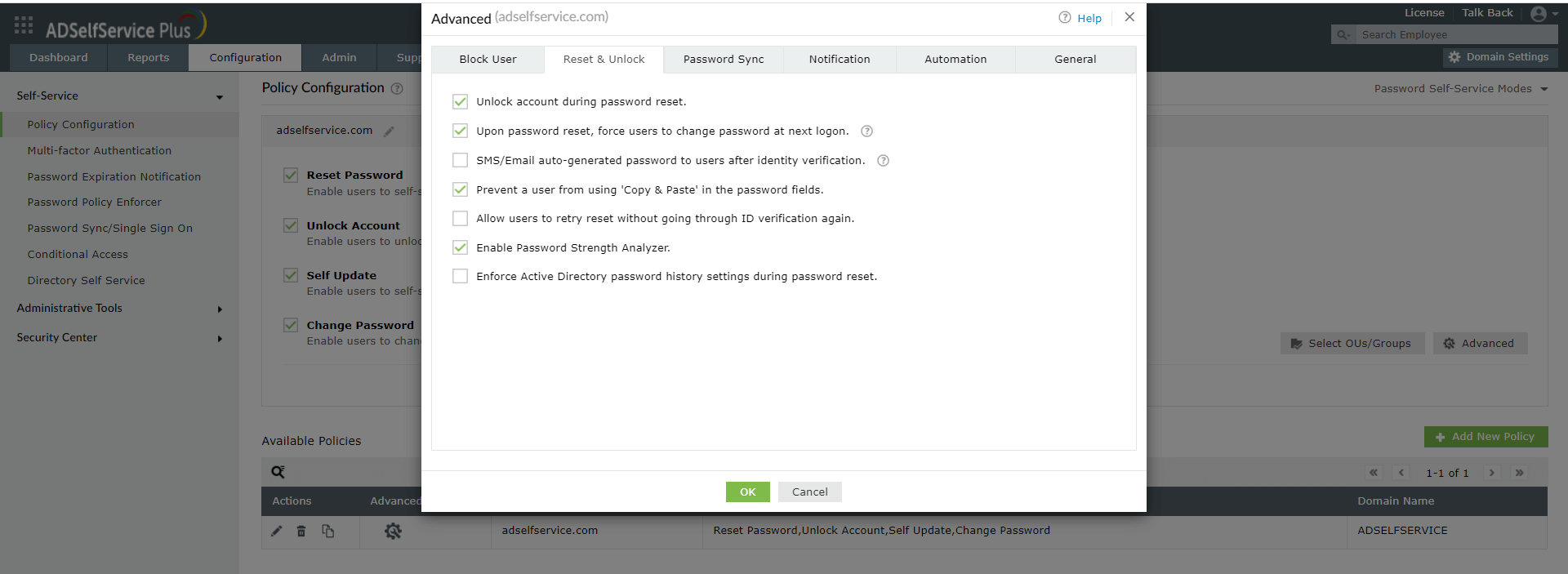Change user password at first logon using PowerShell
The below scripts can force users belonging to specific OUs to change their passwords during their next logon. Often, using PowerShell can be complex and time consuming.
ADSelfService Plus, an Active Directory self-service password management and single sign-on solution, offers an option that, when enabled, forces users to change their password every time they logon after a password reset (self-service or automated password reset).
Here is a comparison between forcing users to change their passwords using PowerShell and ADSelfService Plus:
PowerShell
Get-ADUser -Filter * -SearchBase “OU=<specify-OU-name>,DC=<specify-subdomain-name>,DC=<specify-domain-name>,DC=com” | Set-ADUser -CannotChangePassword:$false -PasswordNeverExpires:$false -ChangePasswordAtLogon:$true
ADSelfService Plus
- Go to Configuration > Policy Configuration.
- Create a new policy.
- Once the information required to create the policy is provided, click on Advanced, navigate to the Reset & Unlock tab and select the Upon password reset, force users to change password at next logon checkbox.
- Click OK and in the Policy Configuration section, click Save.
- Quick configuration:
In ADSelfService Plus, users can be forced to change their passwords during the next logon following a password reset by a few clicks and entering minimal information. In PowerShell, this requires creating, debugging, and running scripts.
- Forced password changes:
Choose who should be forced to change their passwords: When creating an ADSelfService policy, administrators can select the domain, OUs, and groups whose users should be forced to change their password during the next logon following a password reset. Using PowerShell to force specific users to change their passwords will require creating an extensive script
- Data management:
ADSelfService Plus does not store the user's credentials anywhere, unlike the above PowerShell script which requires storing the user's credentials in the script.
- Enforcing strong passwords:
ADSelfService Plus' Password Policy Enforcer allows administrators to create and enforce custom password policies that inhibit the creation of weak passwords that are vulnerable to hacks. Again, in ADSelfService Plus, this can be done in a few clicks, unlike PowerShell which involves creating scripts
- Synchronize AD password with enterprise applications:
Using ADSelfService Plus' Password Synchronization feature, any changes made to the users' passwords can be automatically synchronized with their user account in enterprise applications like G Suite and Office 365.
Force users to change their Active Directory passwords
Get 30-day free trialRelated Resources
- Password Expiry Email Notification using powershell
- Account Expiry Notification using Powershell Script
- How to unlock active directory user account using Powershell Script?
- How to sync active directory password with Office 365 using Powershell
- How to blacklist weak Active Directory passwords
- Self-service Active Directory Password Reset with Powershell
- Powershell Script to Reset User's Password in Google Apps
- How to audit Active Directory Password Quality using Powershell
- Office 365 Password Policy with PowerShell
- How to change user password at first logon using Powershell Script
- How to reset an Azure Active Directory User Password using Powershell
- How to automate Password Reset with Powershell Command
- How to automate unlock with powershell
- How to Get Password Age with Powershell
- How to change Local User Password Remotely using PowerShell script
- How to identify Active Directory Users with Pwned Passwords using Powershell?
- How to self-update active directory details using Powershell
- Powershell password security best practices
- How to enforce password policy for AD user using powershell
- How to get fine-grained password policy using Powershell
- How to sync password between ad domains using Powershell?
- How to find bad password attempts in Active Directory using PowerShell












